September 2025
Special Focus: Refining Technologies
Maximization of FCCU performance by improved FCC feed injection nozzles
Fluid catalytic cracking (FCC) is a widely used process in the refining industry, enabling the conversion of heavy, low-value hydrocarbon liquids into liquefied petroleum gas (LPG) and light and middle distillates. The reaction in the FCC process primarily occurs in the vapor phase, where the liquid feed gets vaporized by hot regenerated catalyst particles. The resulting vapors then enter the catalyst’s pores and undergo cracking into lighter components. Given the extremely short residence time—only a few seconds—the liquid feed must vaporize instantaneously, which necessitates fine atomization and efficient mixing with the catalyst.
The atomization of FCC feed is accomplished through a series of feed injection nozzles. Typically, the feed is introduced into the riser via multiple symmetrically arranged nozzles. A well-designed feed nozzle disperses the liquid feed into fine droplets that immediately vaporize upon contact with the hot catalysts. Several key factors determine the nozzle’s effectiveness, including droplet size and velocity, spray angle, riser coverage area, pressure drop across the nozzle and its mechanical durability to withstand erosion.
A properly designed nozzle may improve the performance of an FCCU in multiple ways (FIG. 1). Efficient utilization of steam will decrease steam consumption and reduce the sour water production from the unit. The pressure drop across the nozzle should be low to minimize the feed pumping energy. The droplet size should be small to achieve quick evaporation. A wide-angled spray pattern with optimum velocity should be used to cover the maximum riser cross section and minimize the attrition of catalyst particles and, consequently, catalyst loss. Metallurgy is another important aspect, as the nozzle is vulnerable to erosion from the fast-moving catalyst particles. Equipment coking can be minimized by suppressing thermal cracking. Reduced thermal cracking also results in improved desired liquid yield and reduced dry gas and delta coke.
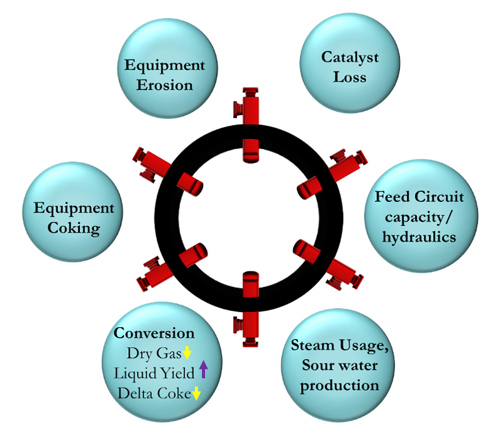
FIG. 1. The impact of feed injection nozzles in an FCCU.
The feed nozzle, which must be replaced every 4 yr–5 yr, is a key component for effective performance of an FCCU and is typically designed and supplied by process licensors. By understating the science of atomization and the various pathways for efficient design of an FCC feed nozzle, the authors’ company initiated the development of efficient and cost-effective FCC feed nozzlesa with the objective of improving operational reliability and performance. Extensive in-house research resulted in the development of efficient and patented FCC feed nozzlesa.
Feed injection nozzlea development. At the authors’ company’s research and development center, different feed nozzle prototypes were developed and tested in a state-of-the-art spray test bench facility using an air-water system to study spray patterns and spray characteristics. The process flow scheme of the spray test facility is provided in FIG. 2. Water stored in a water tank is pumped to the required pressure and flowrate and is supplied to a prototype nozzle. High-pressure air is also supplied separately to the nozzle. Water-air mixing takes place inside the nozzle, and a spray of fine water droplets is produced. The spray is contained within a transparent collection vessel, and the spray images are captured using a high-speed imaging device that uses shadowgraphy to track droplets. The collected water is pumped back to the water tank to repeat the process.
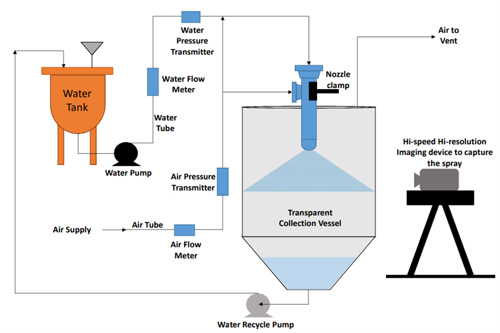
FIG. 2. Process flow diagram of the spray test bench facility.
Twin-fluid atomizers are extensively employed in FCCUs to inject FCC feed into the riser. Since FCC feed is heavy and viscous in nature, steam is used as a diluting medium to reduce the viscosity, improving the flow characteristics. Steam and the hydrocarbon feed enter the feed nozzlea through separate inlets and are mixed vigorously in the mixing zone inside the nozzle. These nozzles have a unique set of internals that help in shearing the liquid into thin sheets, followed by further atomization into fine droplets using steam energy. The thoroughly mixed steam and FCC feed stream exits the nozzle through a tip consisting of multiple holes in the form of a wide-angled spray of fine droplets. For the evaluation of nozzle designs, spray tests were carried out using water-air as fluid (with an air flowrate fixed and equal to 2 wt% of the water flowrate); the backpressure and the diameter of spray droplets at different liquid flowrates were then compared. FIG. 3 shows the spray pattern of a prototype nozzle when tested with the air-water system. FIG. 3a is the pattern obtained in the absence of internals, while FIG. 3b shows the pattern obtained with a unique set of internals. It can be observed that FIG. 3b has a wider spray of finer droplets vs. FIG. 3a.

FIG. 3. A visual comparison of spray patterns: obtained in the absence of internals (a) and obtained with a unique set of internals (b).
It was observed that for the design without internals (FIG. 3a), proper atomization was not taking place, and the spray was dominated by ligaments instead of fine droplets. TABLE 1 details the spray characteristics for the designs shown in FIGS. 3a and 3b.

Demonstration of FCC feed injection nozzlesa. The feed injection nozzlesa were initially installed and commissioned in June 2016 in an FCCU at one of Hindustan Petroleum Corp. Ltd.’s (HPCL’s) refineries. A comparison of test run data of previous nozzles with novel feed injection nozzlesa at identical operating conditions determined that conversion increased by 1.2 wt% with an increased yield of naphtha and a decreased yield of dry gas and resid. Following the success of this project, the feed injection nozzlesa were commissioned in two more FCCUs at HPCL refineries and have resulted in improved conversion and operational reliability.
HPCL refinery FCCU 1. One of the HPCL refineries has a feed capacity of 970,000 tpy. During a turnaround (TAR) in 2016, the existing commercial nozzles were replaced with novel feed injection nozzlesa with no hardware change in the FCC riser. FIG. 4a shows the feed injection nozzlesa installed in the unit, while FIG. 4b shows a nozzlea taken out for inspection after 3 yr of operation. Apart from a few minor indentations on the surface of the tip, the nozzle was unaffected, proving its sound mechanical integrity.
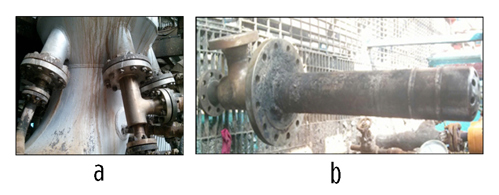
FIG. 4. A view of the feed injection nozzlesa installed in one of HPCL’s refineries (B). An image of the feed injection nozzlesa after 3 yr of operation.
FIG. 4. A view of the feed injection nozzlesa installed in one of HPCL’s refineries (B). An image of the feed injection nozzlesa after 3 yr of operation.
To evaluate the performance of the feed injection nozzlesa, test runs were conducted before and after the TAR under identical operating conditions. FIG. 5 shows the comparison of the product yield pattern and overall conversion before and after the FCCU TAR. The nozzlesa provided a 1.2% higher conversion with 1.5% higher gasoline, 0.3% lower dry gas and 3.5% lower residue yields vs. the initial commercial nozzles. The increase in gasoline yield and the decrease in dry gas and resid yields are an indication of enhanced catalytic cracking due to better atomization of the feed.
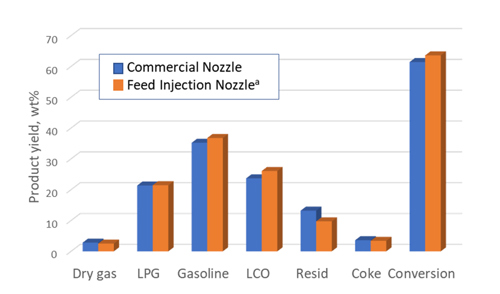
FIG. 5. Comparison of product yield and conversion for HPCL’s FCCU 1.
HPCL refinery FCCU 2. Another FCCU at one of HPCL’s refineries has a feed capacity of 1.22 MMtpy. During a TAR in mid-2016, it was observed that the feed nozzles—imported from the licensor—were severely eroded. It was decided to implement the new feed injection nozzlesa. Two challenged were no modifications in the riser coupled with a short TAR period. The nozzle design was modified, and nozzles were fabricated within a month and delivered to the refinery in time for installation and unit startup.
FIG. 6 shows the comparison of product yields and overall conversion before and after the FCCU TAR. The new nozzlesa provided around 0.8 wt% higher conversion, with an increase of 0.4 wt% in LPG yield, an increase of 0.9 wt% in gasoline yield and a decrease of 0.6 wt% in dry gas yield vs. the previous commercial nozzles.

FIG. 6. Comparison of product yield and conversion for HPCL’s FCCU 2.
HPCL refinery FCCU 3. A third FCCU at one of HPCL’s refineries has a feed capacity of 960,000 tpy. During a TAR in October 2019, it was observed that the licensor-provided feed nozzles were severely eroded (FIG. 7a). These nozzles were also replaced by the authors’ company’s novel nozzlesa (FIG. 7b) during the TAR without any modifications in the riser or feed circuit.
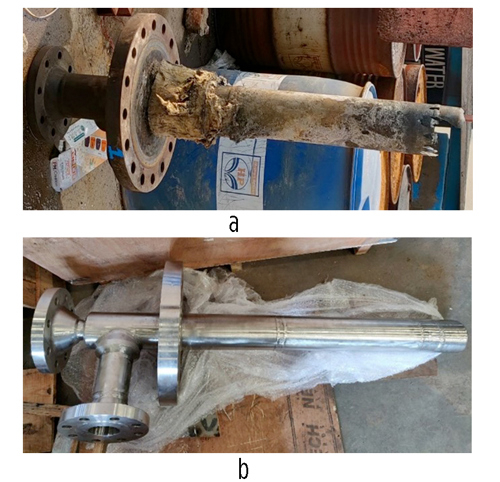
FIG. 7. View of the damaged licensor-provided feed nozzles (A), which were replaced by the authors’ company’s novel nozzlesa (B) during a TAR in October 2019.
FIG. 7. A view of the damaged licensor-provided feed nozzles (a), which were replaced by the authors’ company’s novel nozzlesa (b) during a TAR in October 2019. FIG. 8 shows the comparison of product yields and overall conversion before and after the TAR of FCCU 3 under identical operating conditions. The new nozzlesa provided approximately a 0.5% higher conversion, with an increase of 0.9 wt% in LPG yield and a decrease of 0.3 wt% in dry gas yield vs. the previous commercial nozzles.

FIG. 8. Comparison of product yield and conversion for HPCL’s FCCU 3.
Takeaway. The authors’ company has successfully developed and commercialized a cost-effective FCC feed injection nozzlea with improved operational reliability and performance. The improved performance of these nozzles was verified by analyzing the data obtained from test runs conducted before and after the installation of the feed injection nozzlesa. These novel nozzlesa have helped increase unit conversion by 0.5 wt%–1.2 wt%, with an increase in LPG and gasoline yields and a decrease in dry gas yield in all three units.
NOTE
a HPCL’s SprayMax FCC Feed Injection Nozzles











Comments